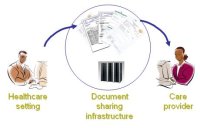CCR or CCD, at least there is now a health record standard


(Picture from the Integrating the Health Enterprise Wiki.)
I called them health reform in action. They put you and your doctor on the same page. You can show it to your family, you can understand it. It's a good thing.
Now there is better news, from the HL7 blog. The two groups working on this stuff, HL7 and the ASTM, have agreed on a technical standard. The good people at HL7 want me to know this is called a Continuity of Care Document (CCD).
CCR or CCD, you can call it genofsky if you like. The point is we now have structured XML standards resulting in an interoperable system for delivering a standardized document to patients. It's all now mapped into HL7's Clinical Document Architecture, making it relatively simple for vendors to implement.
This is technical but it is a very big deal. Doctors will be able to deliver a standard output no matter what Electronic Medical Record (EMR) system they choose.
Since the CCDs will also be computer files, they can be exchanged with other doctors, clinics, and hospitals, reducing duplication of services and the nagging questions you get each time you see a different physician.
One can argue that it's about time. But this is what happens when a lot of people start with a blank sheet of paper and everyone decides they need to own that paper.
Medical practices, and forms, are complex. The format needs to adjust to any specialty, and to any step in a health care process. It's complicated.
But now we may start to see benefits.